CRITICAL APPRAISAL OF QUALITATIVE ARTICLE
VerifiedAdded on 2022/08/29
|14
|3834
|27
AI Summary
Contribute Materials
Your contribution can guide someone’s learning journey. Share your
documents today.
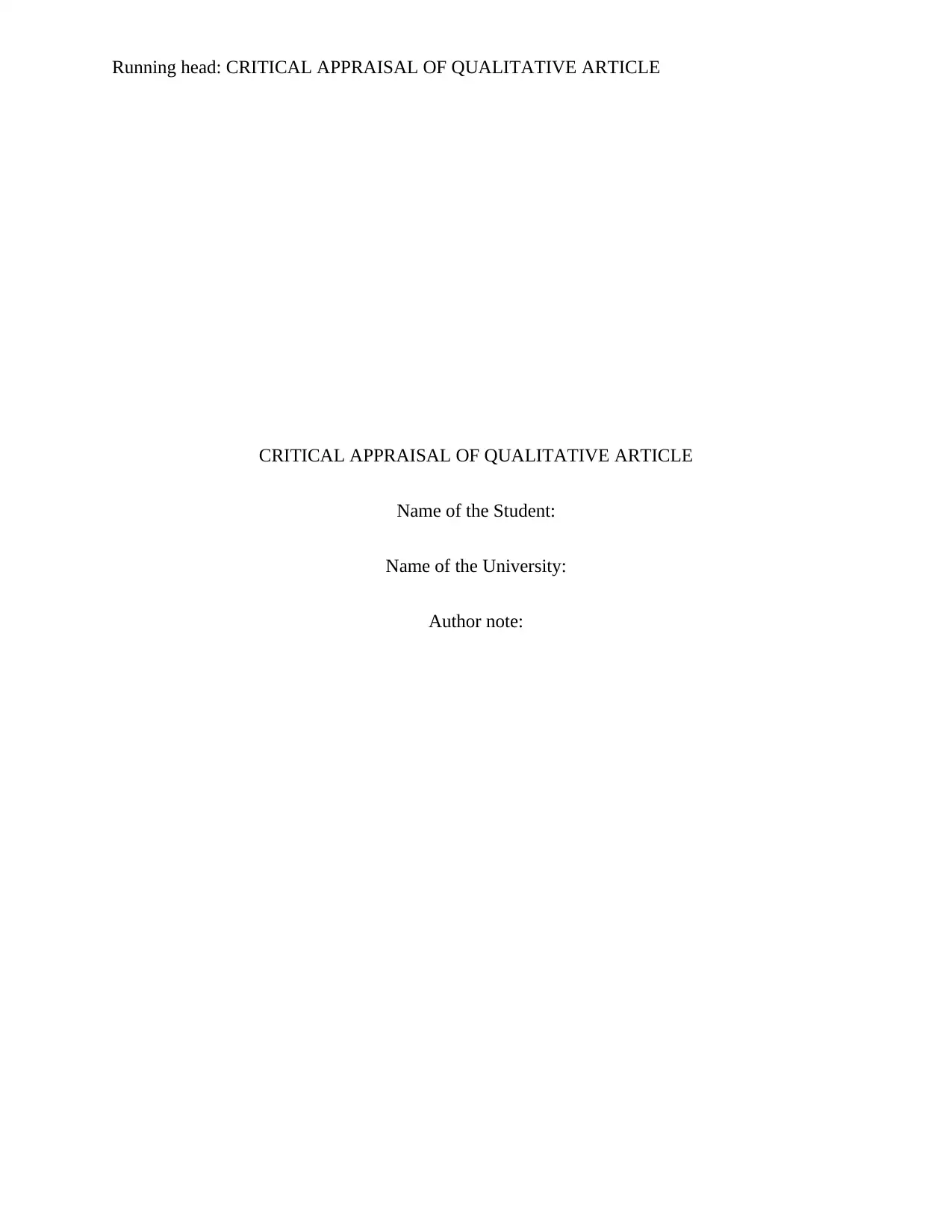
Running head: CRITICAL APPRAISAL OF QUALITATIVE ARTICLE
CRITICAL APPRAISAL OF QUALITATIVE ARTICLE
Name of the Student:
Name of the University:
Author note:
CRITICAL APPRAISAL OF QUALITATIVE ARTICLE
Name of the Student:
Name of the University:
Author note:
Secure Best Marks with AI Grader
Need help grading? Try our AI Grader for instant feedback on your assignments.
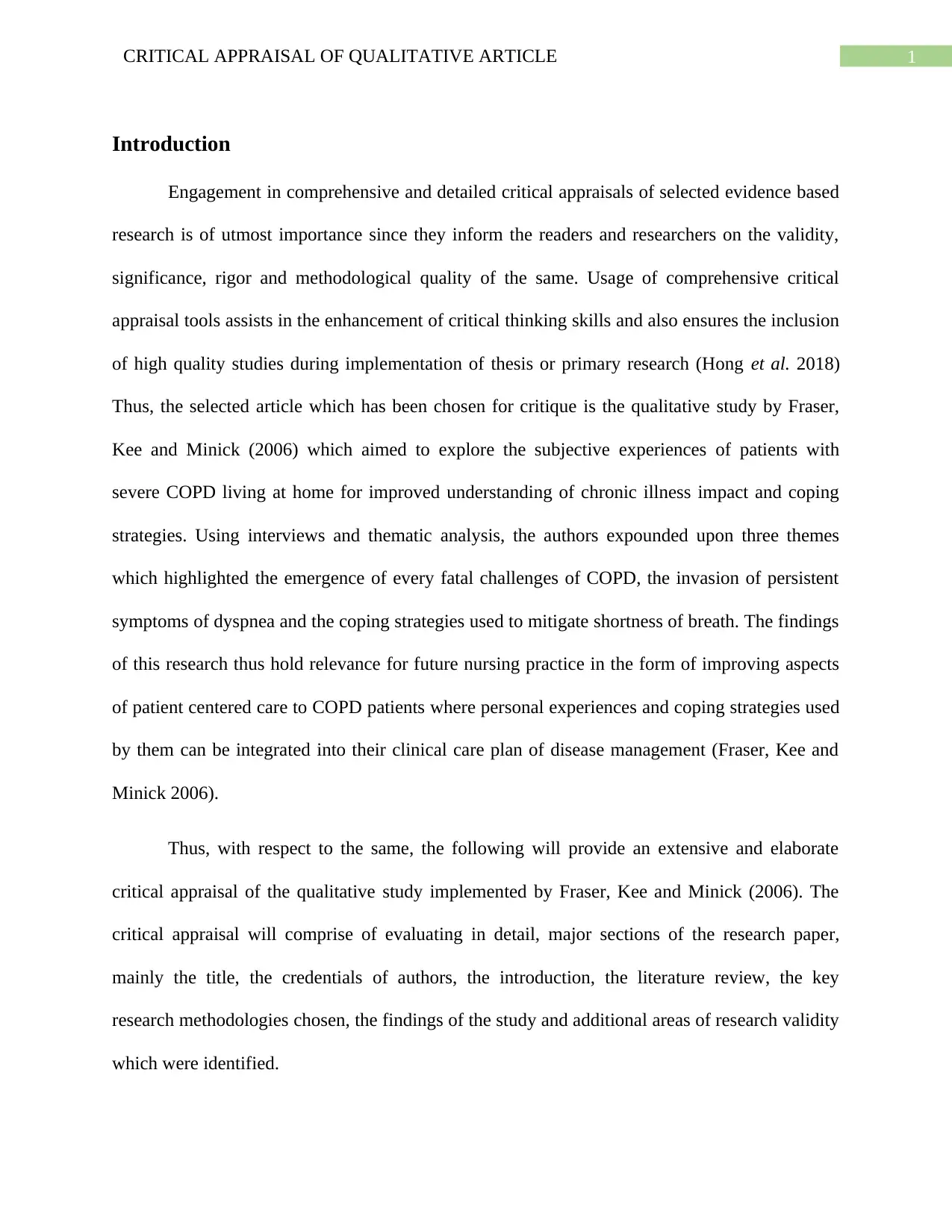
1CRITICAL APPRAISAL OF QUALITATIVE ARTICLE
Introduction
Engagement in comprehensive and detailed critical appraisals of selected evidence based
research is of utmost importance since they inform the readers and researchers on the validity,
significance, rigor and methodological quality of the same. Usage of comprehensive critical
appraisal tools assists in the enhancement of critical thinking skills and also ensures the inclusion
of high quality studies during implementation of thesis or primary research (Hong et al. 2018)
Thus, the selected article which has been chosen for critique is the qualitative study by Fraser,
Kee and Minick (2006) which aimed to explore the subjective experiences of patients with
severe COPD living at home for improved understanding of chronic illness impact and coping
strategies. Using interviews and thematic analysis, the authors expounded upon three themes
which highlighted the emergence of every fatal challenges of COPD, the invasion of persistent
symptoms of dyspnea and the coping strategies used to mitigate shortness of breath. The findings
of this research thus hold relevance for future nursing practice in the form of improving aspects
of patient centered care to COPD patients where personal experiences and coping strategies used
by them can be integrated into their clinical care plan of disease management (Fraser, Kee and
Minick 2006).
Thus, with respect to the same, the following will provide an extensive and elaborate
critical appraisal of the qualitative study implemented by Fraser, Kee and Minick (2006). The
critical appraisal will comprise of evaluating in detail, major sections of the research paper,
mainly the title, the credentials of authors, the introduction, the literature review, the key
research methodologies chosen, the findings of the study and additional areas of research validity
which were identified.
Introduction
Engagement in comprehensive and detailed critical appraisals of selected evidence based
research is of utmost importance since they inform the readers and researchers on the validity,
significance, rigor and methodological quality of the same. Usage of comprehensive critical
appraisal tools assists in the enhancement of critical thinking skills and also ensures the inclusion
of high quality studies during implementation of thesis or primary research (Hong et al. 2018)
Thus, the selected article which has been chosen for critique is the qualitative study by Fraser,
Kee and Minick (2006) which aimed to explore the subjective experiences of patients with
severe COPD living at home for improved understanding of chronic illness impact and coping
strategies. Using interviews and thematic analysis, the authors expounded upon three themes
which highlighted the emergence of every fatal challenges of COPD, the invasion of persistent
symptoms of dyspnea and the coping strategies used to mitigate shortness of breath. The findings
of this research thus hold relevance for future nursing practice in the form of improving aspects
of patient centered care to COPD patients where personal experiences and coping strategies used
by them can be integrated into their clinical care plan of disease management (Fraser, Kee and
Minick 2006).
Thus, with respect to the same, the following will provide an extensive and elaborate
critical appraisal of the qualitative study implemented by Fraser, Kee and Minick (2006). The
critical appraisal will comprise of evaluating in detail, major sections of the research paper,
mainly the title, the credentials of authors, the introduction, the literature review, the key
research methodologies chosen, the findings of the study and additional areas of research validity
which were identified.
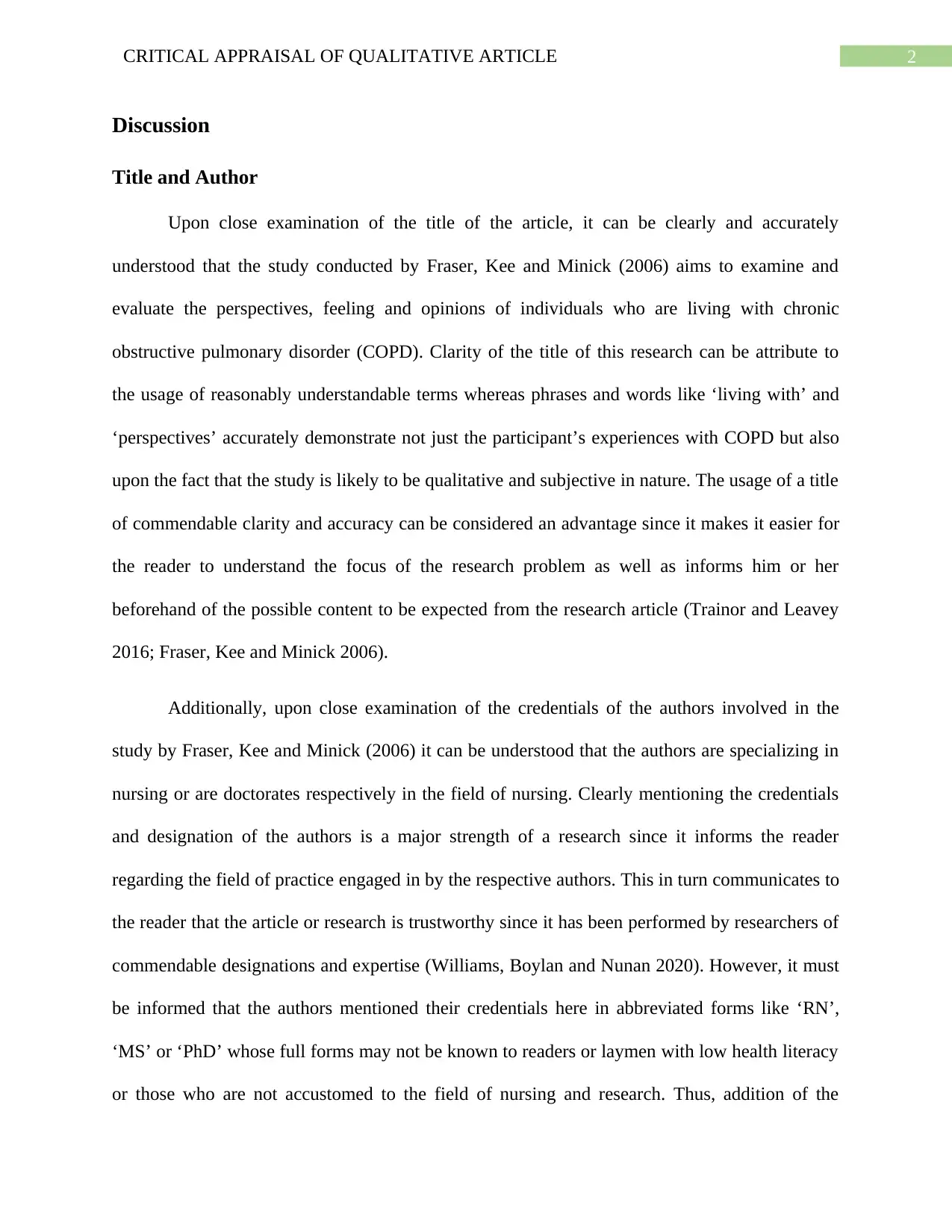
2CRITICAL APPRAISAL OF QUALITATIVE ARTICLE
Discussion
Title and Author
Upon close examination of the title of the article, it can be clearly and accurately
understood that the study conducted by Fraser, Kee and Minick (2006) aims to examine and
evaluate the perspectives, feeling and opinions of individuals who are living with chronic
obstructive pulmonary disorder (COPD). Clarity of the title of this research can be attribute to
the usage of reasonably understandable terms whereas phrases and words like ‘living with’ and
‘perspectives’ accurately demonstrate not just the participant’s experiences with COPD but also
upon the fact that the study is likely to be qualitative and subjective in nature. The usage of a title
of commendable clarity and accuracy can be considered an advantage since it makes it easier for
the reader to understand the focus of the research problem as well as informs him or her
beforehand of the possible content to be expected from the research article (Trainor and Leavey
2016; Fraser, Kee and Minick 2006).
Additionally, upon close examination of the credentials of the authors involved in the
study by Fraser, Kee and Minick (2006) it can be understood that the authors are specializing in
nursing or are doctorates respectively in the field of nursing. Clearly mentioning the credentials
and designation of the authors is a major strength of a research since it informs the reader
regarding the field of practice engaged in by the respective authors. This in turn communicates to
the reader that the article or research is trustworthy since it has been performed by researchers of
commendable designations and expertise (Williams, Boylan and Nunan 2020). However, it must
be informed that the authors mentioned their credentials here in abbreviated forms like ‘RN’,
‘MS’ or ‘PhD’ whose full forms may not be known to readers or laymen with low health literacy
or those who are not accustomed to the field of nursing and research. Thus, addition of the
Discussion
Title and Author
Upon close examination of the title of the article, it can be clearly and accurately
understood that the study conducted by Fraser, Kee and Minick (2006) aims to examine and
evaluate the perspectives, feeling and opinions of individuals who are living with chronic
obstructive pulmonary disorder (COPD). Clarity of the title of this research can be attribute to
the usage of reasonably understandable terms whereas phrases and words like ‘living with’ and
‘perspectives’ accurately demonstrate not just the participant’s experiences with COPD but also
upon the fact that the study is likely to be qualitative and subjective in nature. The usage of a title
of commendable clarity and accuracy can be considered an advantage since it makes it easier for
the reader to understand the focus of the research problem as well as informs him or her
beforehand of the possible content to be expected from the research article (Trainor and Leavey
2016; Fraser, Kee and Minick 2006).
Additionally, upon close examination of the credentials of the authors involved in the
study by Fraser, Kee and Minick (2006) it can be understood that the authors are specializing in
nursing or are doctorates respectively in the field of nursing. Clearly mentioning the credentials
and designation of the authors is a major strength of a research since it informs the reader
regarding the field of practice engaged in by the respective authors. This in turn communicates to
the reader that the article or research is trustworthy since it has been performed by researchers of
commendable designations and expertise (Williams, Boylan and Nunan 2020). However, it must
be informed that the authors mentioned their credentials here in abbreviated forms like ‘RN’,
‘MS’ or ‘PhD’ whose full forms may not be known to readers or laymen with low health literacy
or those who are not accustomed to the field of nursing and research. Thus, addition of the
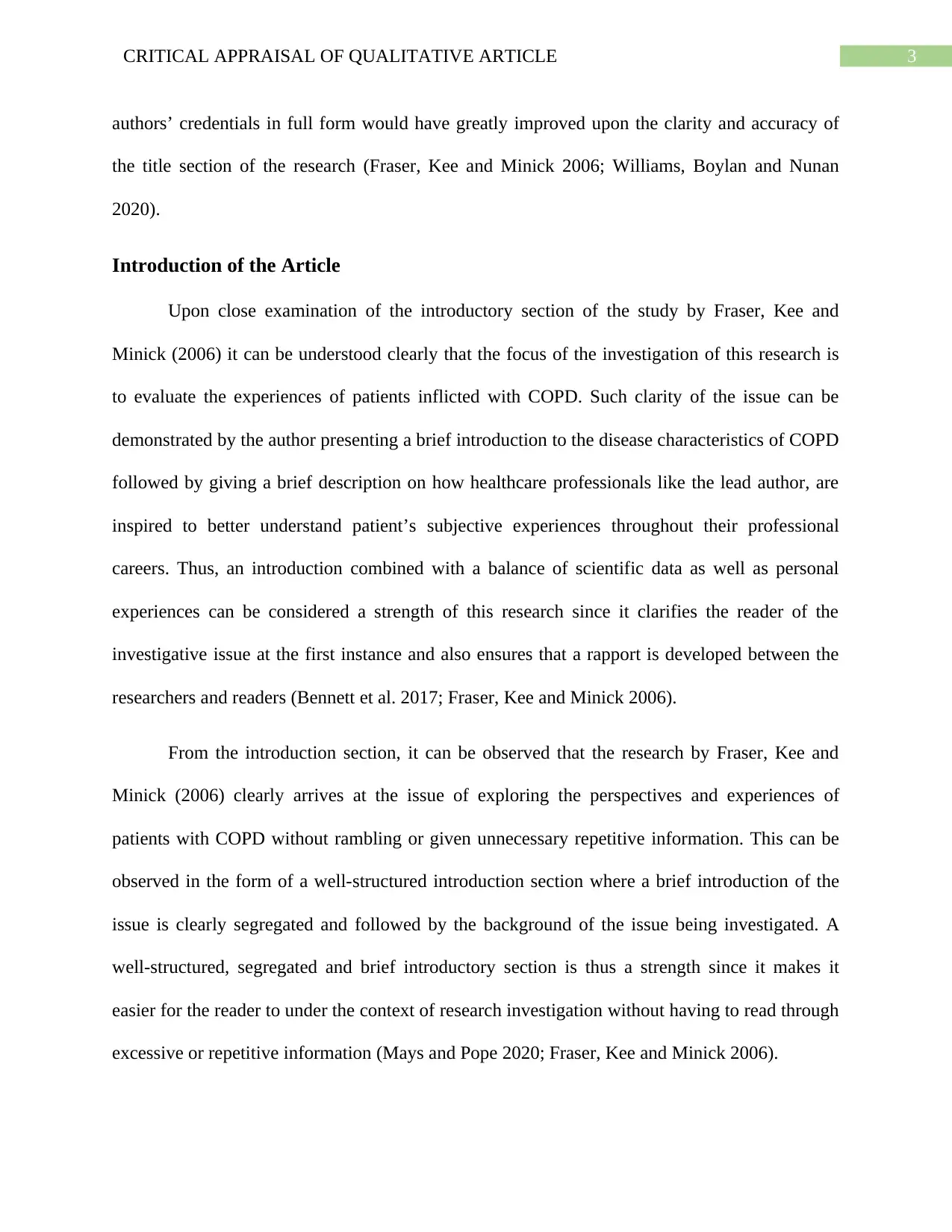
3CRITICAL APPRAISAL OF QUALITATIVE ARTICLE
authors’ credentials in full form would have greatly improved upon the clarity and accuracy of
the title section of the research (Fraser, Kee and Minick 2006; Williams, Boylan and Nunan
2020).
Introduction of the Article
Upon close examination of the introductory section of the study by Fraser, Kee and
Minick (2006) it can be understood clearly that the focus of the investigation of this research is
to evaluate the experiences of patients inflicted with COPD. Such clarity of the issue can be
demonstrated by the author presenting a brief introduction to the disease characteristics of COPD
followed by giving a brief description on how healthcare professionals like the lead author, are
inspired to better understand patient’s subjective experiences throughout their professional
careers. Thus, an introduction combined with a balance of scientific data as well as personal
experiences can be considered a strength of this research since it clarifies the reader of the
investigative issue at the first instance and also ensures that a rapport is developed between the
researchers and readers (Bennett et al. 2017; Fraser, Kee and Minick 2006).
From the introduction section, it can be observed that the research by Fraser, Kee and
Minick (2006) clearly arrives at the issue of exploring the perspectives and experiences of
patients with COPD without rambling or given unnecessary repetitive information. This can be
observed in the form of a well-structured introduction section where a brief introduction of the
issue is clearly segregated and followed by the background of the issue being investigated. A
well-structured, segregated and brief introductory section is thus a strength since it makes it
easier for the reader to under the context of research investigation without having to read through
excessive or repetitive information (Mays and Pope 2020; Fraser, Kee and Minick 2006).
authors’ credentials in full form would have greatly improved upon the clarity and accuracy of
the title section of the research (Fraser, Kee and Minick 2006; Williams, Boylan and Nunan
2020).
Introduction of the Article
Upon close examination of the introductory section of the study by Fraser, Kee and
Minick (2006) it can be understood clearly that the focus of the investigation of this research is
to evaluate the experiences of patients inflicted with COPD. Such clarity of the issue can be
demonstrated by the author presenting a brief introduction to the disease characteristics of COPD
followed by giving a brief description on how healthcare professionals like the lead author, are
inspired to better understand patient’s subjective experiences throughout their professional
careers. Thus, an introduction combined with a balance of scientific data as well as personal
experiences can be considered a strength of this research since it clarifies the reader of the
investigative issue at the first instance and also ensures that a rapport is developed between the
researchers and readers (Bennett et al. 2017; Fraser, Kee and Minick 2006).
From the introduction section, it can be observed that the research by Fraser, Kee and
Minick (2006) clearly arrives at the issue of exploring the perspectives and experiences of
patients with COPD without rambling or given unnecessary repetitive information. This can be
observed in the form of a well-structured introduction section where a brief introduction of the
issue is clearly segregated and followed by the background of the issue being investigated. A
well-structured, segregated and brief introductory section is thus a strength since it makes it
easier for the reader to under the context of research investigation without having to read through
excessive or repetitive information (Mays and Pope 2020; Fraser, Kee and Minick 2006).
Secure Best Marks with AI Grader
Need help grading? Try our AI Grader for instant feedback on your assignments.
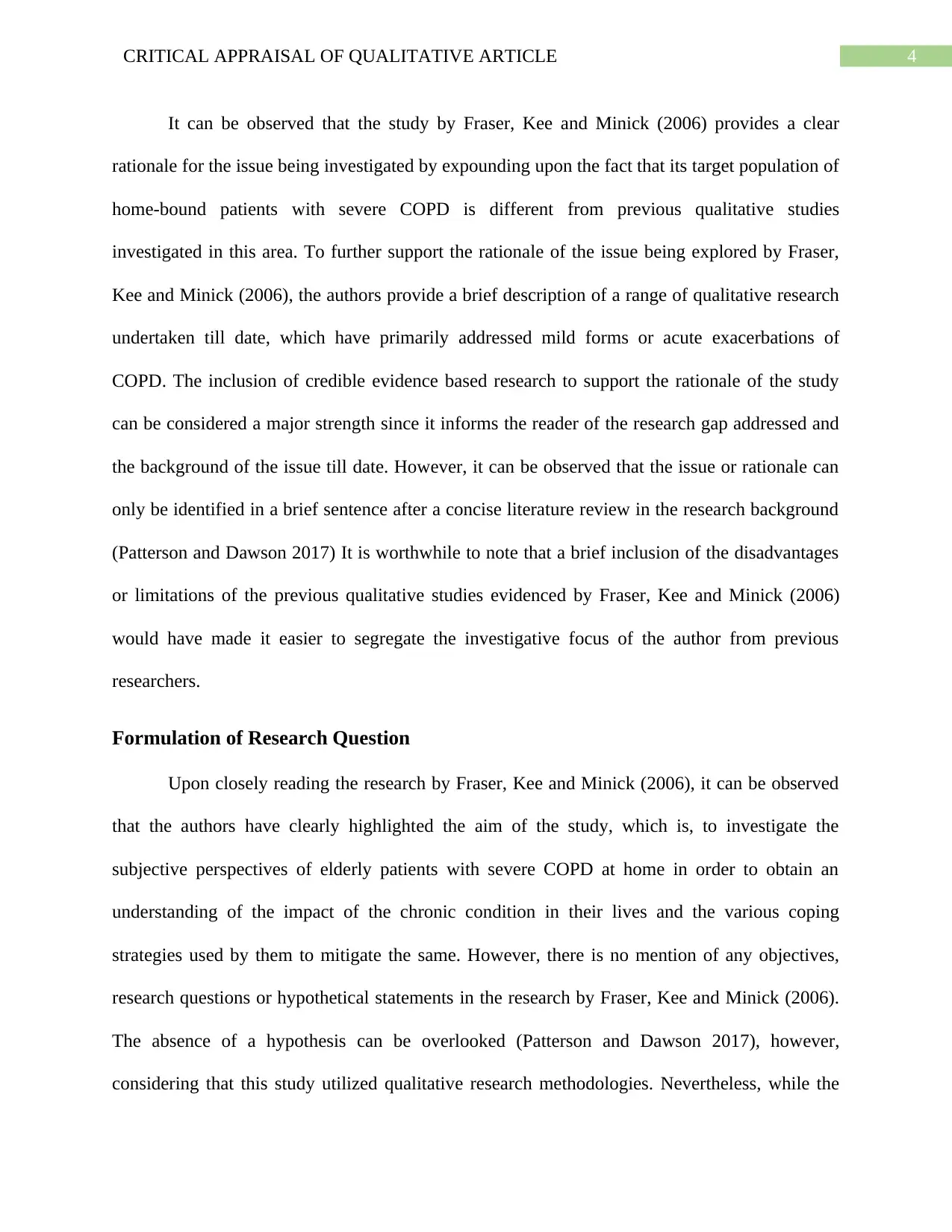
4CRITICAL APPRAISAL OF QUALITATIVE ARTICLE
It can be observed that the study by Fraser, Kee and Minick (2006) provides a clear
rationale for the issue being investigated by expounding upon the fact that its target population of
home-bound patients with severe COPD is different from previous qualitative studies
investigated in this area. To further support the rationale of the issue being explored by Fraser,
Kee and Minick (2006), the authors provide a brief description of a range of qualitative research
undertaken till date, which have primarily addressed mild forms or acute exacerbations of
COPD. The inclusion of credible evidence based research to support the rationale of the study
can be considered a major strength since it informs the reader of the research gap addressed and
the background of the issue till date. However, it can be observed that the issue or rationale can
only be identified in a brief sentence after a concise literature review in the research background
(Patterson and Dawson 2017) It is worthwhile to note that a brief inclusion of the disadvantages
or limitations of the previous qualitative studies evidenced by Fraser, Kee and Minick (2006)
would have made it easier to segregate the investigative focus of the author from previous
researchers.
Formulation of Research Question
Upon closely reading the research by Fraser, Kee and Minick (2006), it can be observed
that the authors have clearly highlighted the aim of the study, which is, to investigate the
subjective perspectives of elderly patients with severe COPD at home in order to obtain an
understanding of the impact of the chronic condition in their lives and the various coping
strategies used by them to mitigate the same. However, there is no mention of any objectives,
research questions or hypothetical statements in the research by Fraser, Kee and Minick (2006).
The absence of a hypothesis can be overlooked (Patterson and Dawson 2017), however,
considering that this study utilized qualitative research methodologies. Nevertheless, while the
It can be observed that the study by Fraser, Kee and Minick (2006) provides a clear
rationale for the issue being investigated by expounding upon the fact that its target population of
home-bound patients with severe COPD is different from previous qualitative studies
investigated in this area. To further support the rationale of the issue being explored by Fraser,
Kee and Minick (2006), the authors provide a brief description of a range of qualitative research
undertaken till date, which have primarily addressed mild forms or acute exacerbations of
COPD. The inclusion of credible evidence based research to support the rationale of the study
can be considered a major strength since it informs the reader of the research gap addressed and
the background of the issue till date. However, it can be observed that the issue or rationale can
only be identified in a brief sentence after a concise literature review in the research background
(Patterson and Dawson 2017) It is worthwhile to note that a brief inclusion of the disadvantages
or limitations of the previous qualitative studies evidenced by Fraser, Kee and Minick (2006)
would have made it easier to segregate the investigative focus of the author from previous
researchers.
Formulation of Research Question
Upon closely reading the research by Fraser, Kee and Minick (2006), it can be observed
that the authors have clearly highlighted the aim of the study, which is, to investigate the
subjective perspectives of elderly patients with severe COPD at home in order to obtain an
understanding of the impact of the chronic condition in their lives and the various coping
strategies used by them to mitigate the same. However, there is no mention of any objectives,
research questions or hypothetical statements in the research by Fraser, Kee and Minick (2006).
The absence of a hypothesis can be overlooked (Patterson and Dawson 2017), however,
considering that this study utilized qualitative research methodologies. Nevertheless, while the
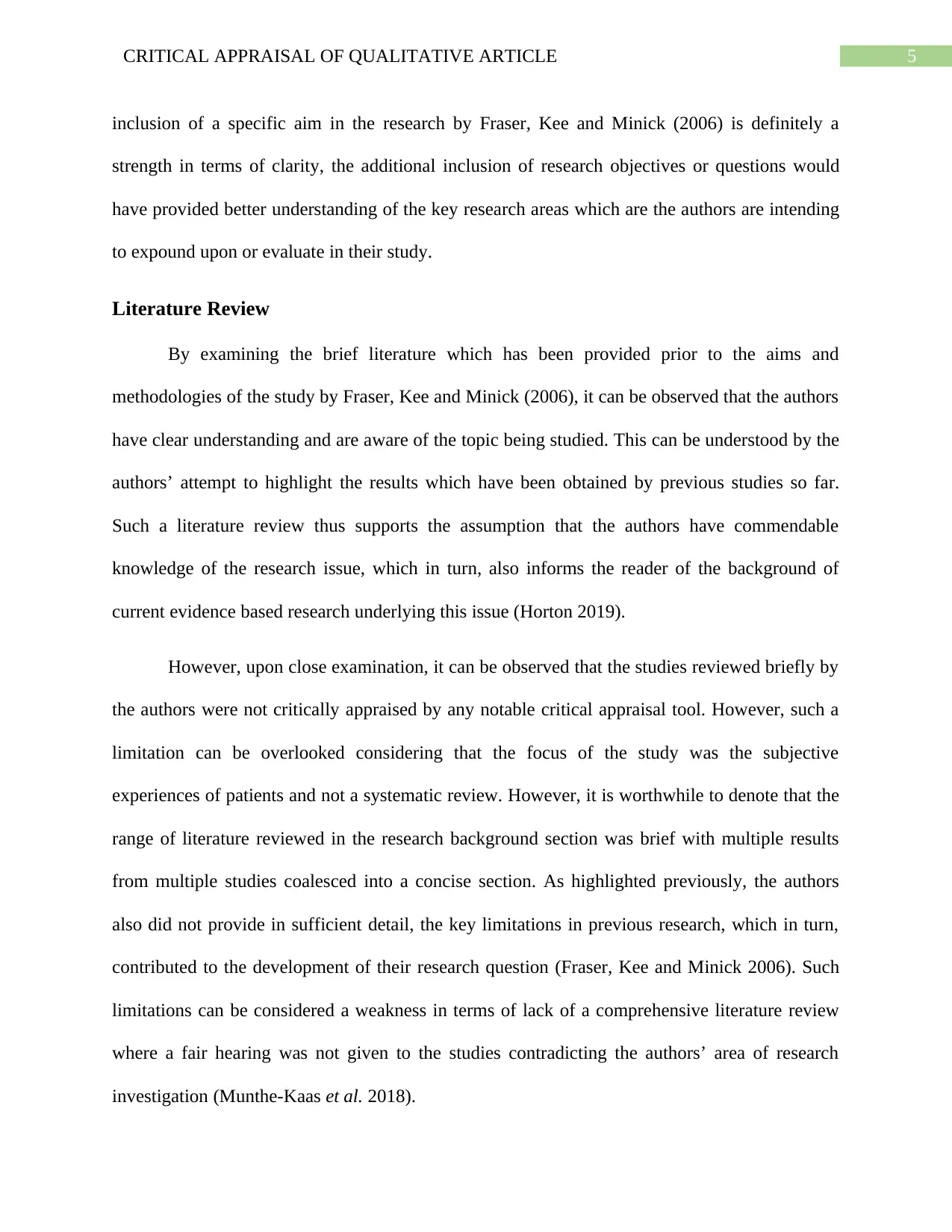
5CRITICAL APPRAISAL OF QUALITATIVE ARTICLE
inclusion of a specific aim in the research by Fraser, Kee and Minick (2006) is definitely a
strength in terms of clarity, the additional inclusion of research objectives or questions would
have provided better understanding of the key research areas which are the authors are intending
to expound upon or evaluate in their study.
Literature Review
By examining the brief literature which has been provided prior to the aims and
methodologies of the study by Fraser, Kee and Minick (2006), it can be observed that the authors
have clear understanding and are aware of the topic being studied. This can be understood by the
authors’ attempt to highlight the results which have been obtained by previous studies so far.
Such a literature review thus supports the assumption that the authors have commendable
knowledge of the research issue, which in turn, also informs the reader of the background of
current evidence based research underlying this issue (Horton 2019).
However, upon close examination, it can be observed that the studies reviewed briefly by
the authors were not critically appraised by any notable critical appraisal tool. However, such a
limitation can be overlooked considering that the focus of the study was the subjective
experiences of patients and not a systematic review. However, it is worthwhile to denote that the
range of literature reviewed in the research background section was brief with multiple results
from multiple studies coalesced into a concise section. As highlighted previously, the authors
also did not provide in sufficient detail, the key limitations in previous research, which in turn,
contributed to the development of their research question (Fraser, Kee and Minick 2006). Such
limitations can be considered a weakness in terms of lack of a comprehensive literature review
where a fair hearing was not given to the studies contradicting the authors’ area of research
investigation (Munthe-Kaas et al. 2018).
inclusion of a specific aim in the research by Fraser, Kee and Minick (2006) is definitely a
strength in terms of clarity, the additional inclusion of research objectives or questions would
have provided better understanding of the key research areas which are the authors are intending
to expound upon or evaluate in their study.
Literature Review
By examining the brief literature which has been provided prior to the aims and
methodologies of the study by Fraser, Kee and Minick (2006), it can be observed that the authors
have clear understanding and are aware of the topic being studied. This can be understood by the
authors’ attempt to highlight the results which have been obtained by previous studies so far.
Such a literature review thus supports the assumption that the authors have commendable
knowledge of the research issue, which in turn, also informs the reader of the background of
current evidence based research underlying this issue (Horton 2019).
However, upon close examination, it can be observed that the studies reviewed briefly by
the authors were not critically appraised by any notable critical appraisal tool. However, such a
limitation can be overlooked considering that the focus of the study was the subjective
experiences of patients and not a systematic review. However, it is worthwhile to denote that the
range of literature reviewed in the research background section was brief with multiple results
from multiple studies coalesced into a concise section. As highlighted previously, the authors
also did not provide in sufficient detail, the key limitations in previous research, which in turn,
contributed to the development of their research question (Fraser, Kee and Minick 2006). Such
limitations can be considered a weakness in terms of lack of a comprehensive literature review
where a fair hearing was not given to the studies contradicting the authors’ area of research
investigation (Munthe-Kaas et al. 2018).
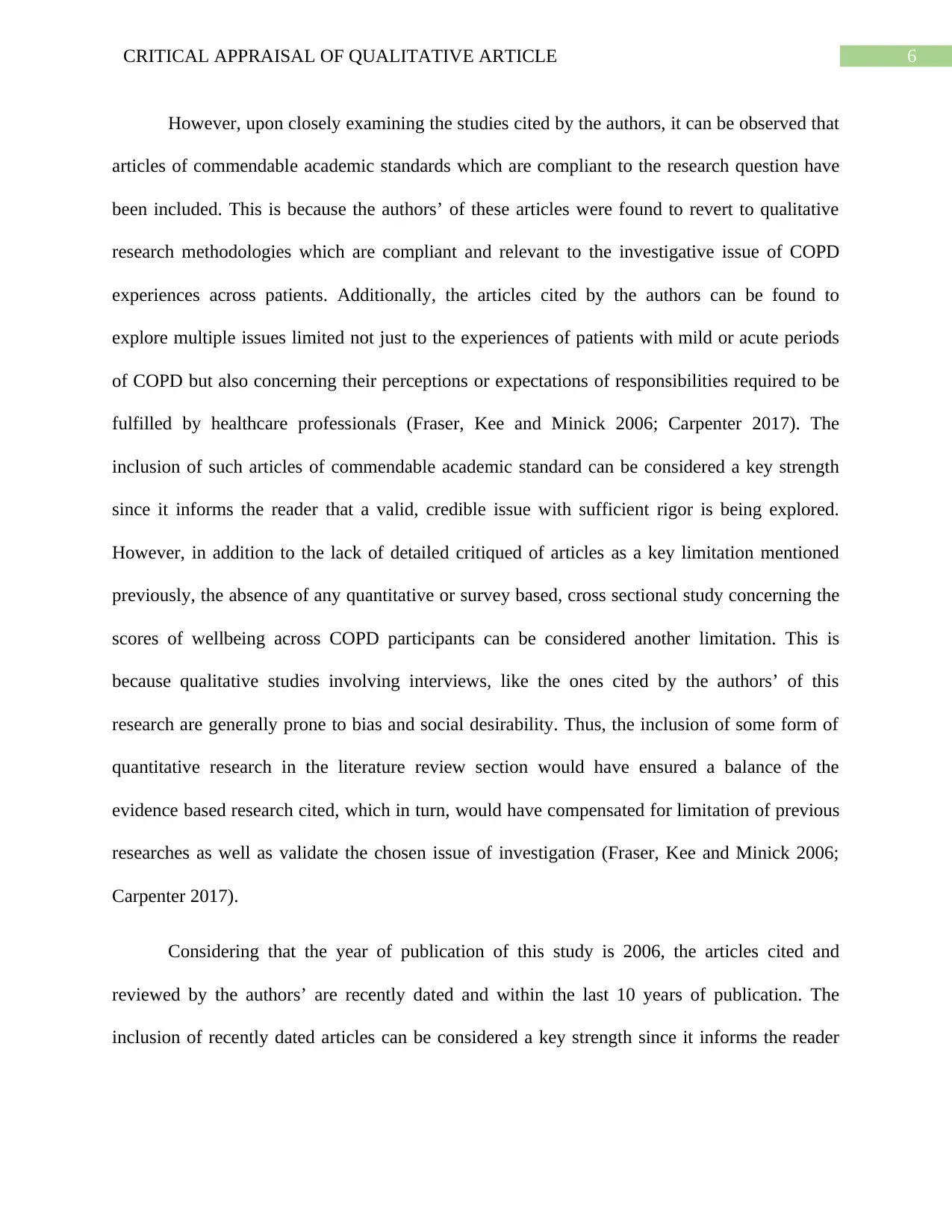
6CRITICAL APPRAISAL OF QUALITATIVE ARTICLE
However, upon closely examining the studies cited by the authors, it can be observed that
articles of commendable academic standards which are compliant to the research question have
been included. This is because the authors’ of these articles were found to revert to qualitative
research methodologies which are compliant and relevant to the investigative issue of COPD
experiences across patients. Additionally, the articles cited by the authors can be found to
explore multiple issues limited not just to the experiences of patients with mild or acute periods
of COPD but also concerning their perceptions or expectations of responsibilities required to be
fulfilled by healthcare professionals (Fraser, Kee and Minick 2006; Carpenter 2017). The
inclusion of such articles of commendable academic standard can be considered a key strength
since it informs the reader that a valid, credible issue with sufficient rigor is being explored.
However, in addition to the lack of detailed critiqued of articles as a key limitation mentioned
previously, the absence of any quantitative or survey based, cross sectional study concerning the
scores of wellbeing across COPD participants can be considered another limitation. This is
because qualitative studies involving interviews, like the ones cited by the authors’ of this
research are generally prone to bias and social desirability. Thus, the inclusion of some form of
quantitative research in the literature review section would have ensured a balance of the
evidence based research cited, which in turn, would have compensated for limitation of previous
researches as well as validate the chosen issue of investigation (Fraser, Kee and Minick 2006;
Carpenter 2017).
Considering that the year of publication of this study is 2006, the articles cited and
reviewed by the authors’ are recently dated and within the last 10 years of publication. The
inclusion of recently dated articles can be considered a key strength since it informs the reader
However, upon closely examining the studies cited by the authors, it can be observed that
articles of commendable academic standards which are compliant to the research question have
been included. This is because the authors’ of these articles were found to revert to qualitative
research methodologies which are compliant and relevant to the investigative issue of COPD
experiences across patients. Additionally, the articles cited by the authors can be found to
explore multiple issues limited not just to the experiences of patients with mild or acute periods
of COPD but also concerning their perceptions or expectations of responsibilities required to be
fulfilled by healthcare professionals (Fraser, Kee and Minick 2006; Carpenter 2017). The
inclusion of such articles of commendable academic standard can be considered a key strength
since it informs the reader that a valid, credible issue with sufficient rigor is being explored.
However, in addition to the lack of detailed critiqued of articles as a key limitation mentioned
previously, the absence of any quantitative or survey based, cross sectional study concerning the
scores of wellbeing across COPD participants can be considered another limitation. This is
because qualitative studies involving interviews, like the ones cited by the authors’ of this
research are generally prone to bias and social desirability. Thus, the inclusion of some form of
quantitative research in the literature review section would have ensured a balance of the
evidence based research cited, which in turn, would have compensated for limitation of previous
researches as well as validate the chosen issue of investigation (Fraser, Kee and Minick 2006;
Carpenter 2017).
Considering that the year of publication of this study is 2006, the articles cited and
reviewed by the authors’ are recently dated and within the last 10 years of publication. The
inclusion of recently dated articles can be considered a key strength since it informs the reader
Paraphrase This Document
Need a fresh take? Get an instant paraphrase of this document with our AI Paraphraser
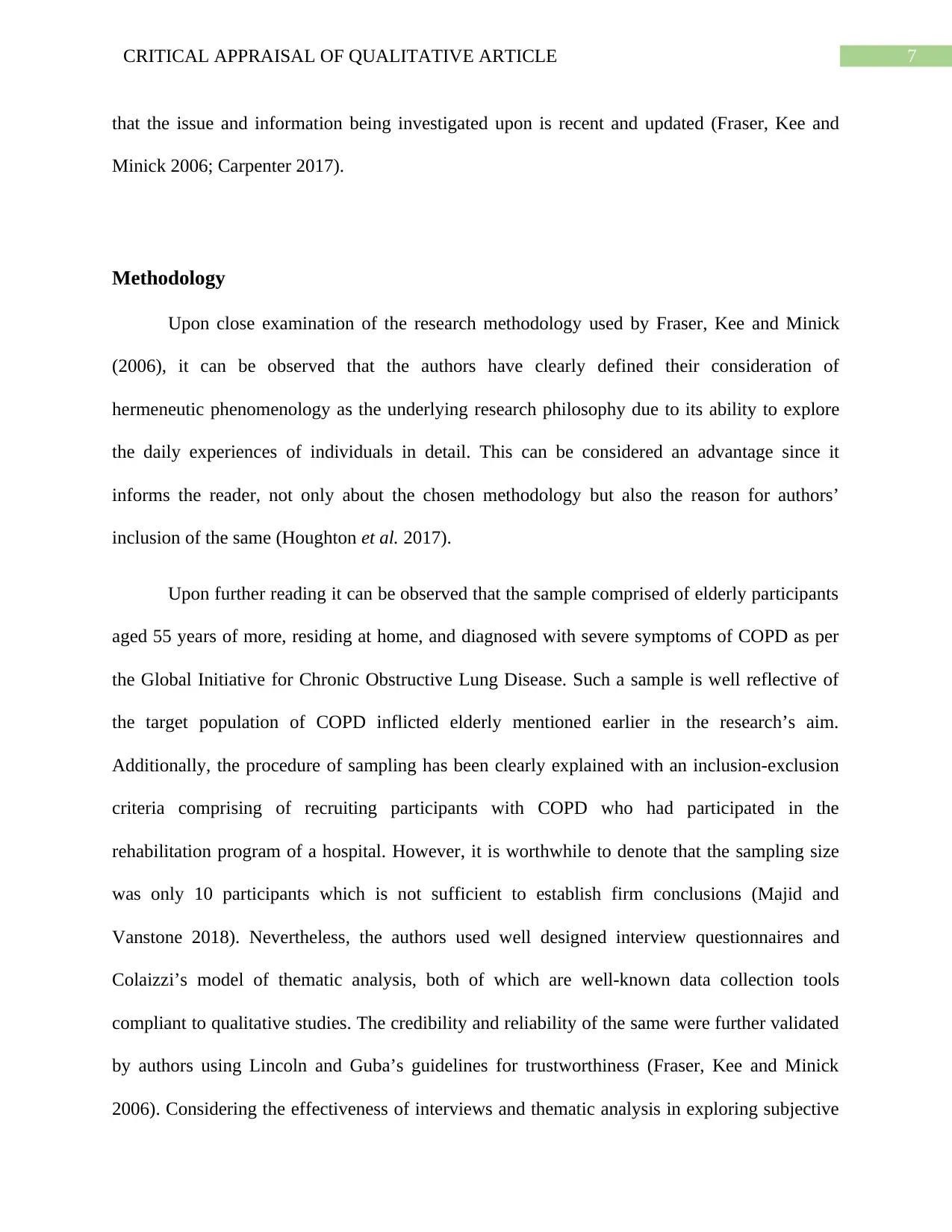
7CRITICAL APPRAISAL OF QUALITATIVE ARTICLE
that the issue and information being investigated upon is recent and updated (Fraser, Kee and
Minick 2006; Carpenter 2017).
Methodology
Upon close examination of the research methodology used by Fraser, Kee and Minick
(2006), it can be observed that the authors have clearly defined their consideration of
hermeneutic phenomenology as the underlying research philosophy due to its ability to explore
the daily experiences of individuals in detail. This can be considered an advantage since it
informs the reader, not only about the chosen methodology but also the reason for authors’
inclusion of the same (Houghton et al. 2017).
Upon further reading it can be observed that the sample comprised of elderly participants
aged 55 years of more, residing at home, and diagnosed with severe symptoms of COPD as per
the Global Initiative for Chronic Obstructive Lung Disease. Such a sample is well reflective of
the target population of COPD inflicted elderly mentioned earlier in the research’s aim.
Additionally, the procedure of sampling has been clearly explained with an inclusion-exclusion
criteria comprising of recruiting participants with COPD who had participated in the
rehabilitation program of a hospital. However, it is worthwhile to denote that the sampling size
was only 10 participants which is not sufficient to establish firm conclusions (Majid and
Vanstone 2018). Nevertheless, the authors used well designed interview questionnaires and
Colaizzi’s model of thematic analysis, both of which are well-known data collection tools
compliant to qualitative studies. The credibility and reliability of the same were further validated
by authors using Lincoln and Guba’s guidelines for trustworthiness (Fraser, Kee and Minick
2006). Considering the effectiveness of interviews and thematic analysis in exploring subjective
that the issue and information being investigated upon is recent and updated (Fraser, Kee and
Minick 2006; Carpenter 2017).
Methodology
Upon close examination of the research methodology used by Fraser, Kee and Minick
(2006), it can be observed that the authors have clearly defined their consideration of
hermeneutic phenomenology as the underlying research philosophy due to its ability to explore
the daily experiences of individuals in detail. This can be considered an advantage since it
informs the reader, not only about the chosen methodology but also the reason for authors’
inclusion of the same (Houghton et al. 2017).
Upon further reading it can be observed that the sample comprised of elderly participants
aged 55 years of more, residing at home, and diagnosed with severe symptoms of COPD as per
the Global Initiative for Chronic Obstructive Lung Disease. Such a sample is well reflective of
the target population of COPD inflicted elderly mentioned earlier in the research’s aim.
Additionally, the procedure of sampling has been clearly explained with an inclusion-exclusion
criteria comprising of recruiting participants with COPD who had participated in the
rehabilitation program of a hospital. However, it is worthwhile to denote that the sampling size
was only 10 participants which is not sufficient to establish firm conclusions (Majid and
Vanstone 2018). Nevertheless, the authors used well designed interview questionnaires and
Colaizzi’s model of thematic analysis, both of which are well-known data collection tools
compliant to qualitative studies. The credibility and reliability of the same were further validated
by authors using Lincoln and Guba’s guidelines for trustworthiness (Fraser, Kee and Minick
2006). Considering the effectiveness of interviews and thematic analysis in exploring subjective
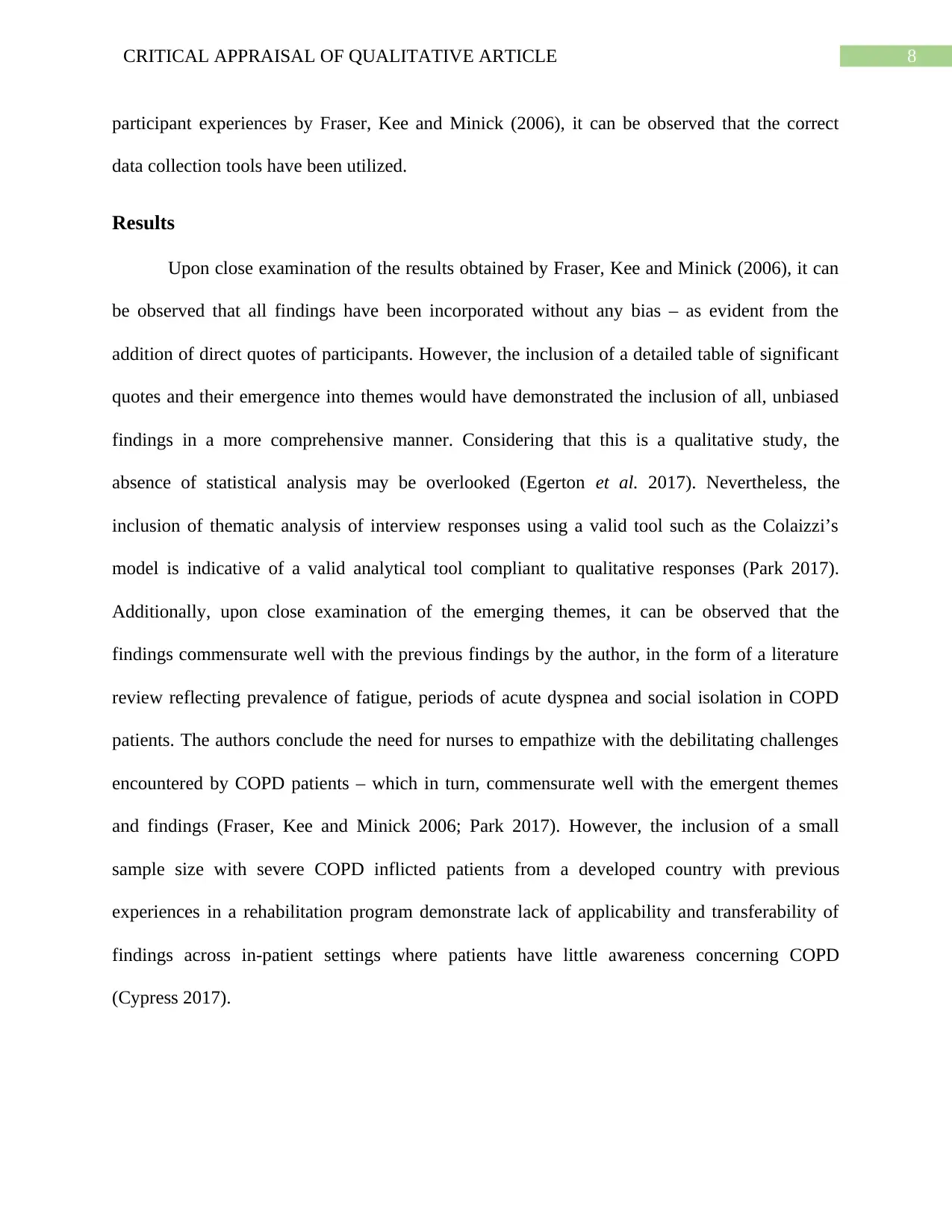
8CRITICAL APPRAISAL OF QUALITATIVE ARTICLE
participant experiences by Fraser, Kee and Minick (2006), it can be observed that the correct
data collection tools have been utilized.
Results
Upon close examination of the results obtained by Fraser, Kee and Minick (2006), it can
be observed that all findings have been incorporated without any bias – as evident from the
addition of direct quotes of participants. However, the inclusion of a detailed table of significant
quotes and their emergence into themes would have demonstrated the inclusion of all, unbiased
findings in a more comprehensive manner. Considering that this is a qualitative study, the
absence of statistical analysis may be overlooked (Egerton et al. 2017). Nevertheless, the
inclusion of thematic analysis of interview responses using a valid tool such as the Colaizzi’s
model is indicative of a valid analytical tool compliant to qualitative responses (Park 2017).
Additionally, upon close examination of the emerging themes, it can be observed that the
findings commensurate well with the previous findings by the author, in the form of a literature
review reflecting prevalence of fatigue, periods of acute dyspnea and social isolation in COPD
patients. The authors conclude the need for nurses to empathize with the debilitating challenges
encountered by COPD patients – which in turn, commensurate well with the emergent themes
and findings (Fraser, Kee and Minick 2006; Park 2017). However, the inclusion of a small
sample size with severe COPD inflicted patients from a developed country with previous
experiences in a rehabilitation program demonstrate lack of applicability and transferability of
findings across in-patient settings where patients have little awareness concerning COPD
(Cypress 2017).
participant experiences by Fraser, Kee and Minick (2006), it can be observed that the correct
data collection tools have been utilized.
Results
Upon close examination of the results obtained by Fraser, Kee and Minick (2006), it can
be observed that all findings have been incorporated without any bias – as evident from the
addition of direct quotes of participants. However, the inclusion of a detailed table of significant
quotes and their emergence into themes would have demonstrated the inclusion of all, unbiased
findings in a more comprehensive manner. Considering that this is a qualitative study, the
absence of statistical analysis may be overlooked (Egerton et al. 2017). Nevertheless, the
inclusion of thematic analysis of interview responses using a valid tool such as the Colaizzi’s
model is indicative of a valid analytical tool compliant to qualitative responses (Park 2017).
Additionally, upon close examination of the emerging themes, it can be observed that the
findings commensurate well with the previous findings by the author, in the form of a literature
review reflecting prevalence of fatigue, periods of acute dyspnea and social isolation in COPD
patients. The authors conclude the need for nurses to empathize with the debilitating challenges
encountered by COPD patients – which in turn, commensurate well with the emergent themes
and findings (Fraser, Kee and Minick 2006; Park 2017). However, the inclusion of a small
sample size with severe COPD inflicted patients from a developed country with previous
experiences in a rehabilitation program demonstrate lack of applicability and transferability of
findings across in-patient settings where patients have little awareness concerning COPD
(Cypress 2017).
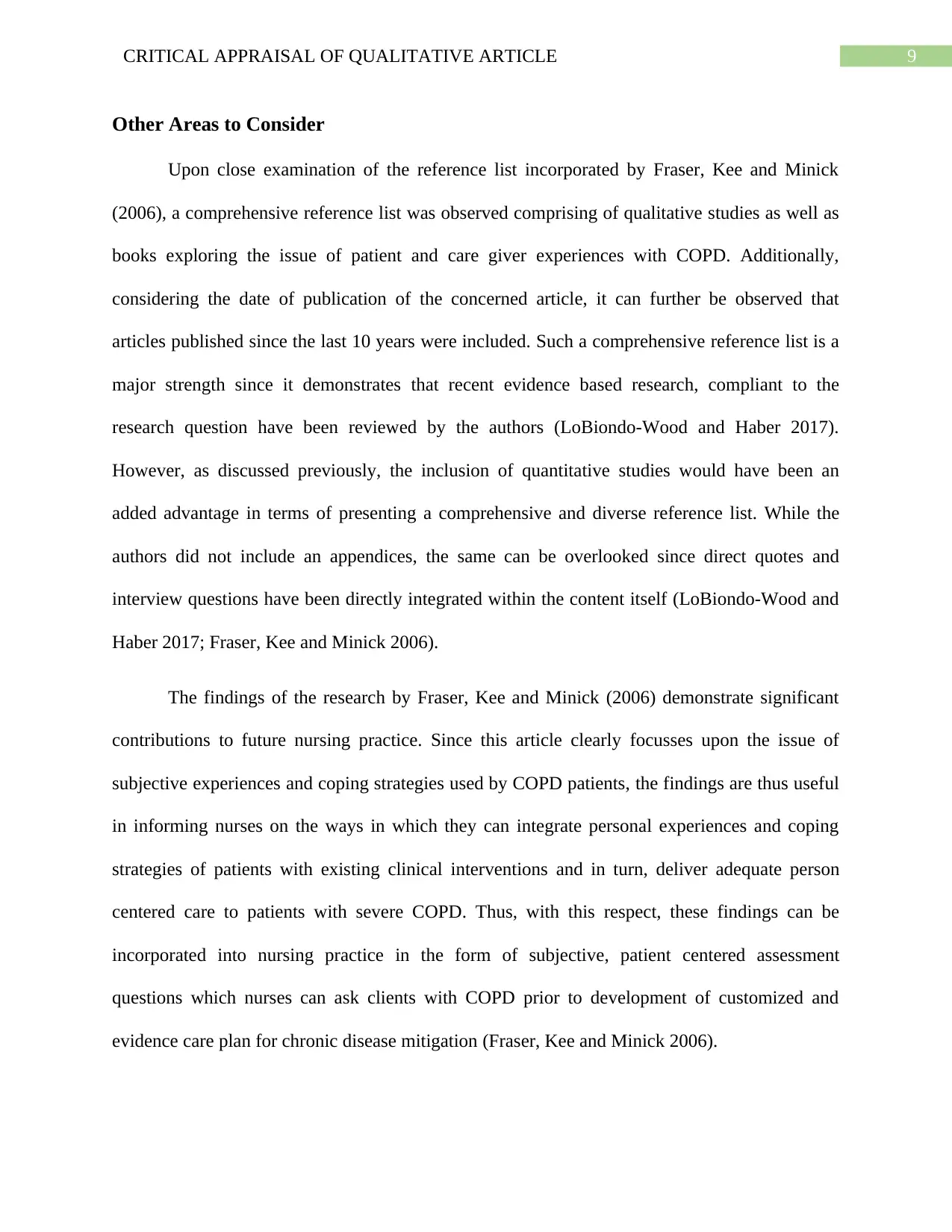
9CRITICAL APPRAISAL OF QUALITATIVE ARTICLE
Other Areas to Consider
Upon close examination of the reference list incorporated by Fraser, Kee and Minick
(2006), a comprehensive reference list was observed comprising of qualitative studies as well as
books exploring the issue of patient and care giver experiences with COPD. Additionally,
considering the date of publication of the concerned article, it can further be observed that
articles published since the last 10 years were included. Such a comprehensive reference list is a
major strength since it demonstrates that recent evidence based research, compliant to the
research question have been reviewed by the authors (LoBiondo-Wood and Haber 2017).
However, as discussed previously, the inclusion of quantitative studies would have been an
added advantage in terms of presenting a comprehensive and diverse reference list. While the
authors did not include an appendices, the same can be overlooked since direct quotes and
interview questions have been directly integrated within the content itself (LoBiondo-Wood and
Haber 2017; Fraser, Kee and Minick 2006).
The findings of the research by Fraser, Kee and Minick (2006) demonstrate significant
contributions to future nursing practice. Since this article clearly focusses upon the issue of
subjective experiences and coping strategies used by COPD patients, the findings are thus useful
in informing nurses on the ways in which they can integrate personal experiences and coping
strategies of patients with existing clinical interventions and in turn, deliver adequate person
centered care to patients with severe COPD. Thus, with this respect, these findings can be
incorporated into nursing practice in the form of subjective, patient centered assessment
questions which nurses can ask clients with COPD prior to development of customized and
evidence care plan for chronic disease mitigation (Fraser, Kee and Minick 2006).
Other Areas to Consider
Upon close examination of the reference list incorporated by Fraser, Kee and Minick
(2006), a comprehensive reference list was observed comprising of qualitative studies as well as
books exploring the issue of patient and care giver experiences with COPD. Additionally,
considering the date of publication of the concerned article, it can further be observed that
articles published since the last 10 years were included. Such a comprehensive reference list is a
major strength since it demonstrates that recent evidence based research, compliant to the
research question have been reviewed by the authors (LoBiondo-Wood and Haber 2017).
However, as discussed previously, the inclusion of quantitative studies would have been an
added advantage in terms of presenting a comprehensive and diverse reference list. While the
authors did not include an appendices, the same can be overlooked since direct quotes and
interview questions have been directly integrated within the content itself (LoBiondo-Wood and
Haber 2017; Fraser, Kee and Minick 2006).
The findings of the research by Fraser, Kee and Minick (2006) demonstrate significant
contributions to future nursing practice. Since this article clearly focusses upon the issue of
subjective experiences and coping strategies used by COPD patients, the findings are thus useful
in informing nurses on the ways in which they can integrate personal experiences and coping
strategies of patients with existing clinical interventions and in turn, deliver adequate person
centered care to patients with severe COPD. Thus, with this respect, these findings can be
incorporated into nursing practice in the form of subjective, patient centered assessment
questions which nurses can ask clients with COPD prior to development of customized and
evidence care plan for chronic disease mitigation (Fraser, Kee and Minick 2006).
Secure Best Marks with AI Grader
Need help grading? Try our AI Grader for instant feedback on your assignments.
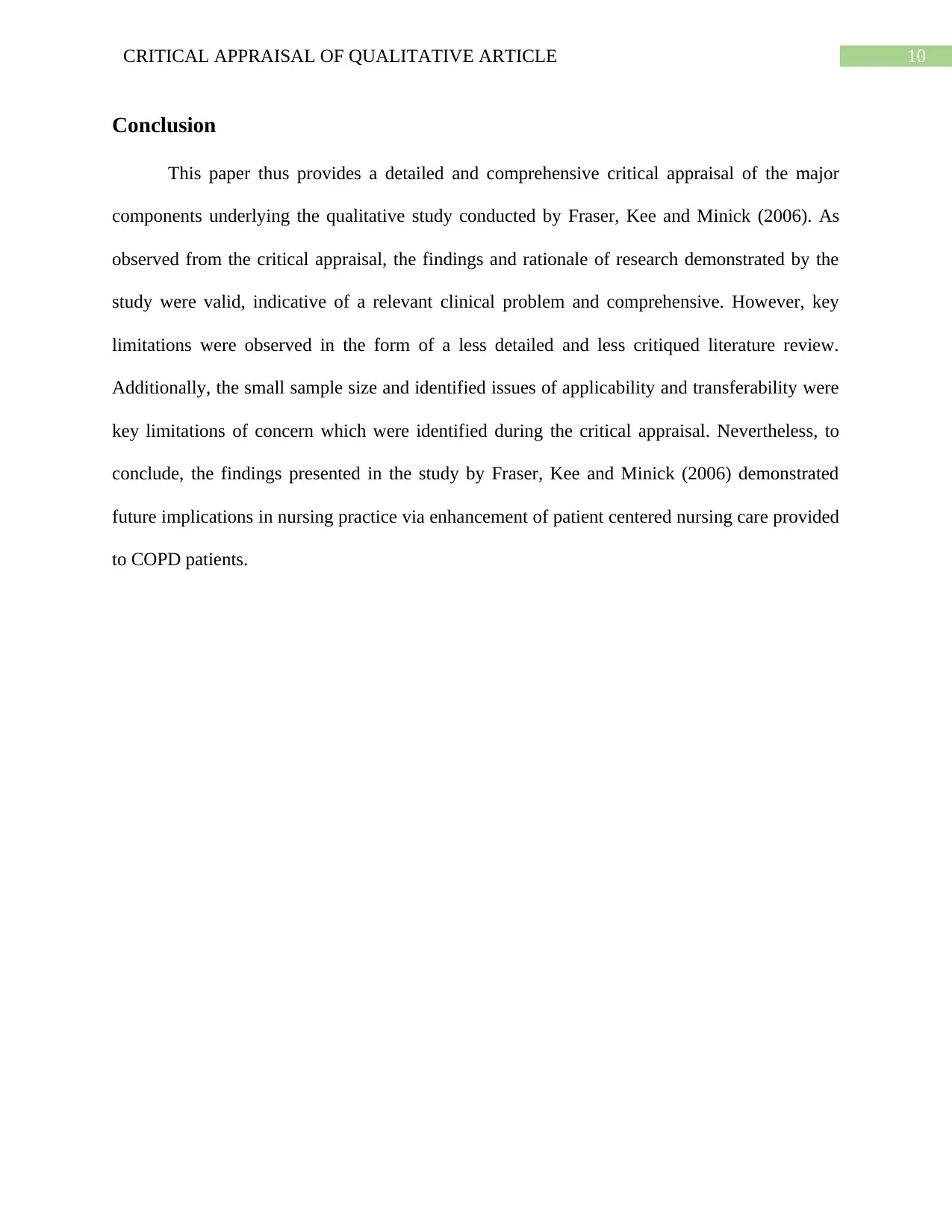
10CRITICAL APPRAISAL OF QUALITATIVE ARTICLE
Conclusion
This paper thus provides a detailed and comprehensive critical appraisal of the major
components underlying the qualitative study conducted by Fraser, Kee and Minick (2006). As
observed from the critical appraisal, the findings and rationale of research demonstrated by the
study were valid, indicative of a relevant clinical problem and comprehensive. However, key
limitations were observed in the form of a less detailed and less critiqued literature review.
Additionally, the small sample size and identified issues of applicability and transferability were
key limitations of concern which were identified during the critical appraisal. Nevertheless, to
conclude, the findings presented in the study by Fraser, Kee and Minick (2006) demonstrated
future implications in nursing practice via enhancement of patient centered nursing care provided
to COPD patients.
Conclusion
This paper thus provides a detailed and comprehensive critical appraisal of the major
components underlying the qualitative study conducted by Fraser, Kee and Minick (2006). As
observed from the critical appraisal, the findings and rationale of research demonstrated by the
study were valid, indicative of a relevant clinical problem and comprehensive. However, key
limitations were observed in the form of a less detailed and less critiqued literature review.
Additionally, the small sample size and identified issues of applicability and transferability were
key limitations of concern which were identified during the critical appraisal. Nevertheless, to
conclude, the findings presented in the study by Fraser, Kee and Minick (2006) demonstrated
future implications in nursing practice via enhancement of patient centered nursing care provided
to COPD patients.
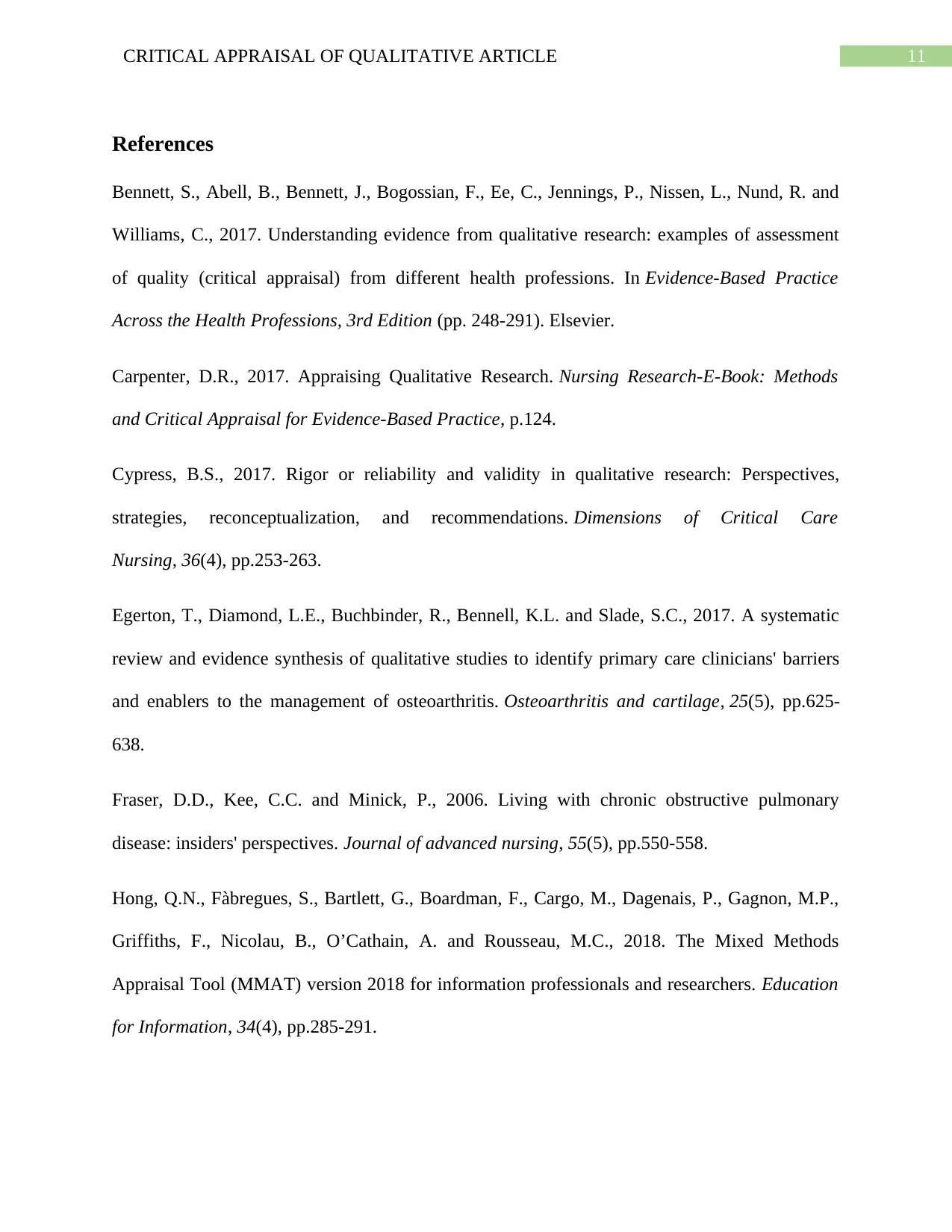
11CRITICAL APPRAISAL OF QUALITATIVE ARTICLE
References
Bennett, S., Abell, B., Bennett, J., Bogossian, F., Ee, C., Jennings, P., Nissen, L., Nund, R. and
Williams, C., 2017. Understanding evidence from qualitative research: examples of assessment
of quality (critical appraisal) from different health professions. In Evidence-Based Practice
Across the Health Professions, 3rd Edition (pp. 248-291). Elsevier.
Carpenter, D.R., 2017. Appraising Qualitative Research. Nursing Research-E-Book: Methods
and Critical Appraisal for Evidence-Based Practice, p.124.
Cypress, B.S., 2017. Rigor or reliability and validity in qualitative research: Perspectives,
strategies, reconceptualization, and recommendations. Dimensions of Critical Care
Nursing, 36(4), pp.253-263.
Egerton, T., Diamond, L.E., Buchbinder, R., Bennell, K.L. and Slade, S.C., 2017. A systematic
review and evidence synthesis of qualitative studies to identify primary care clinicians' barriers
and enablers to the management of osteoarthritis. Osteoarthritis and cartilage, 25(5), pp.625-
638.
Fraser, D.D., Kee, C.C. and Minick, P., 2006. Living with chronic obstructive pulmonary
disease: insiders' perspectives. Journal of advanced nursing, 55(5), pp.550-558.
Hong, Q.N., Fàbregues, S., Bartlett, G., Boardman, F., Cargo, M., Dagenais, P., Gagnon, M.P.,
Griffiths, F., Nicolau, B., O’Cathain, A. and Rousseau, M.C., 2018. The Mixed Methods
Appraisal Tool (MMAT) version 2018 for information professionals and researchers. Education
for Information, 34(4), pp.285-291.
References
Bennett, S., Abell, B., Bennett, J., Bogossian, F., Ee, C., Jennings, P., Nissen, L., Nund, R. and
Williams, C., 2017. Understanding evidence from qualitative research: examples of assessment
of quality (critical appraisal) from different health professions. In Evidence-Based Practice
Across the Health Professions, 3rd Edition (pp. 248-291). Elsevier.
Carpenter, D.R., 2017. Appraising Qualitative Research. Nursing Research-E-Book: Methods
and Critical Appraisal for Evidence-Based Practice, p.124.
Cypress, B.S., 2017. Rigor or reliability and validity in qualitative research: Perspectives,
strategies, reconceptualization, and recommendations. Dimensions of Critical Care
Nursing, 36(4), pp.253-263.
Egerton, T., Diamond, L.E., Buchbinder, R., Bennell, K.L. and Slade, S.C., 2017. A systematic
review and evidence synthesis of qualitative studies to identify primary care clinicians' barriers
and enablers to the management of osteoarthritis. Osteoarthritis and cartilage, 25(5), pp.625-
638.
Fraser, D.D., Kee, C.C. and Minick, P., 2006. Living with chronic obstructive pulmonary
disease: insiders' perspectives. Journal of advanced nursing, 55(5), pp.550-558.
Hong, Q.N., Fàbregues, S., Bartlett, G., Boardman, F., Cargo, M., Dagenais, P., Gagnon, M.P.,
Griffiths, F., Nicolau, B., O’Cathain, A. and Rousseau, M.C., 2018. The Mixed Methods
Appraisal Tool (MMAT) version 2018 for information professionals and researchers. Education
for Information, 34(4), pp.285-291.
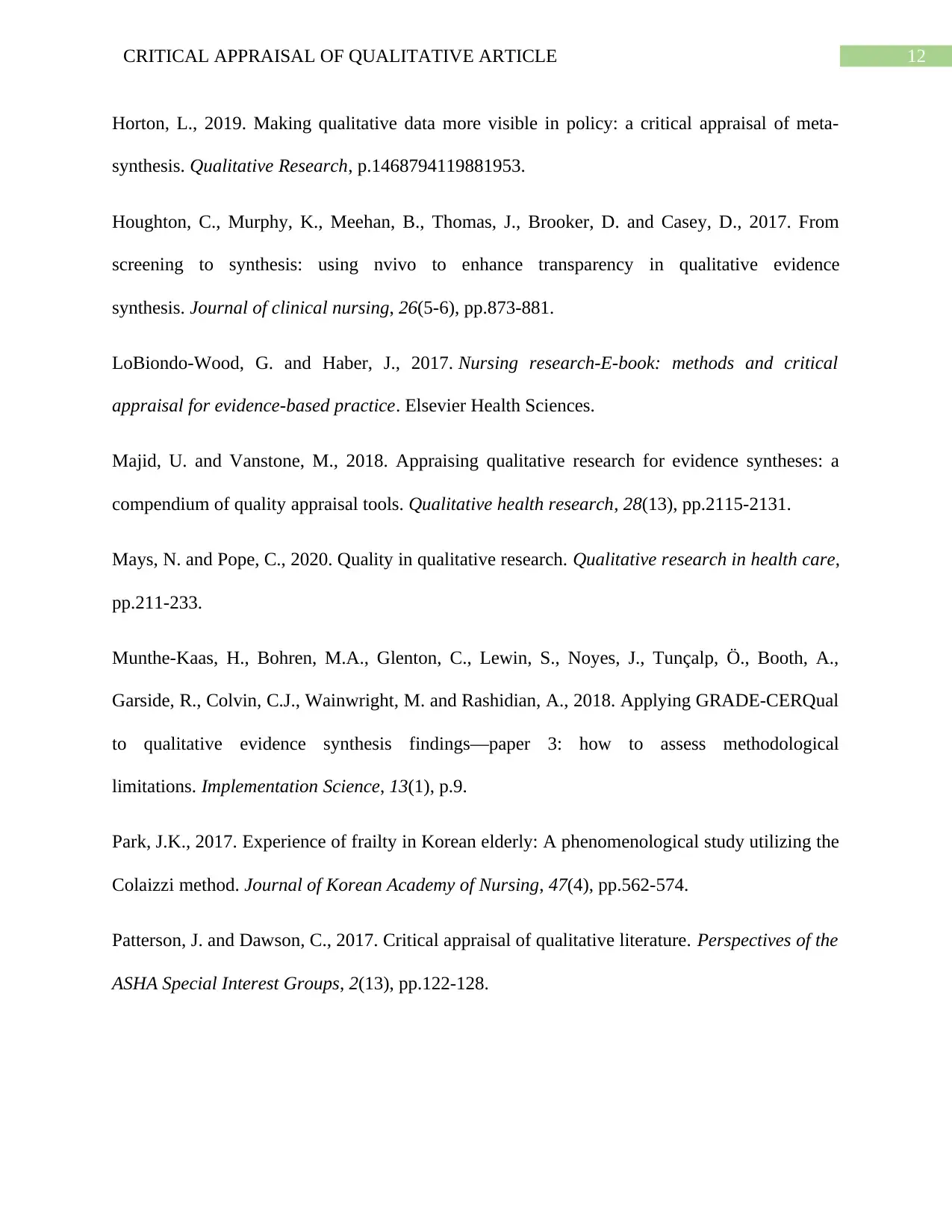
12CRITICAL APPRAISAL OF QUALITATIVE ARTICLE
Horton, L., 2019. Making qualitative data more visible in policy: a critical appraisal of meta-
synthesis. Qualitative Research, p.1468794119881953.
Houghton, C., Murphy, K., Meehan, B., Thomas, J., Brooker, D. and Casey, D., 2017. From
screening to synthesis: using nvivo to enhance transparency in qualitative evidence
synthesis. Journal of clinical nursing, 26(5-6), pp.873-881.
LoBiondo-Wood, G. and Haber, J., 2017. Nursing research-E-book: methods and critical
appraisal for evidence-based practice. Elsevier Health Sciences.
Majid, U. and Vanstone, M., 2018. Appraising qualitative research for evidence syntheses: a
compendium of quality appraisal tools. Qualitative health research, 28(13), pp.2115-2131.
Mays, N. and Pope, C., 2020. Quality in qualitative research. Qualitative research in health care,
pp.211-233.
Munthe-Kaas, H., Bohren, M.A., Glenton, C., Lewin, S., Noyes, J., Tunçalp, Ö., Booth, A.,
Garside, R., Colvin, C.J., Wainwright, M. and Rashidian, A., 2018. Applying GRADE-CERQual
to qualitative evidence synthesis findings—paper 3: how to assess methodological
limitations. Implementation Science, 13(1), p.9.
Park, J.K., 2017. Experience of frailty in Korean elderly: A phenomenological study utilizing the
Colaizzi method. Journal of Korean Academy of Nursing, 47(4), pp.562-574.
Patterson, J. and Dawson, C., 2017. Critical appraisal of qualitative literature. Perspectives of the
ASHA Special Interest Groups, 2(13), pp.122-128.
Horton, L., 2019. Making qualitative data more visible in policy: a critical appraisal of meta-
synthesis. Qualitative Research, p.1468794119881953.
Houghton, C., Murphy, K., Meehan, B., Thomas, J., Brooker, D. and Casey, D., 2017. From
screening to synthesis: using nvivo to enhance transparency in qualitative evidence
synthesis. Journal of clinical nursing, 26(5-6), pp.873-881.
LoBiondo-Wood, G. and Haber, J., 2017. Nursing research-E-book: methods and critical
appraisal for evidence-based practice. Elsevier Health Sciences.
Majid, U. and Vanstone, M., 2018. Appraising qualitative research for evidence syntheses: a
compendium of quality appraisal tools. Qualitative health research, 28(13), pp.2115-2131.
Mays, N. and Pope, C., 2020. Quality in qualitative research. Qualitative research in health care,
pp.211-233.
Munthe-Kaas, H., Bohren, M.A., Glenton, C., Lewin, S., Noyes, J., Tunçalp, Ö., Booth, A.,
Garside, R., Colvin, C.J., Wainwright, M. and Rashidian, A., 2018. Applying GRADE-CERQual
to qualitative evidence synthesis findings—paper 3: how to assess methodological
limitations. Implementation Science, 13(1), p.9.
Park, J.K., 2017. Experience of frailty in Korean elderly: A phenomenological study utilizing the
Colaizzi method. Journal of Korean Academy of Nursing, 47(4), pp.562-574.
Patterson, J. and Dawson, C., 2017. Critical appraisal of qualitative literature. Perspectives of the
ASHA Special Interest Groups, 2(13), pp.122-128.
Paraphrase This Document
Need a fresh take? Get an instant paraphrase of this document with our AI Paraphraser
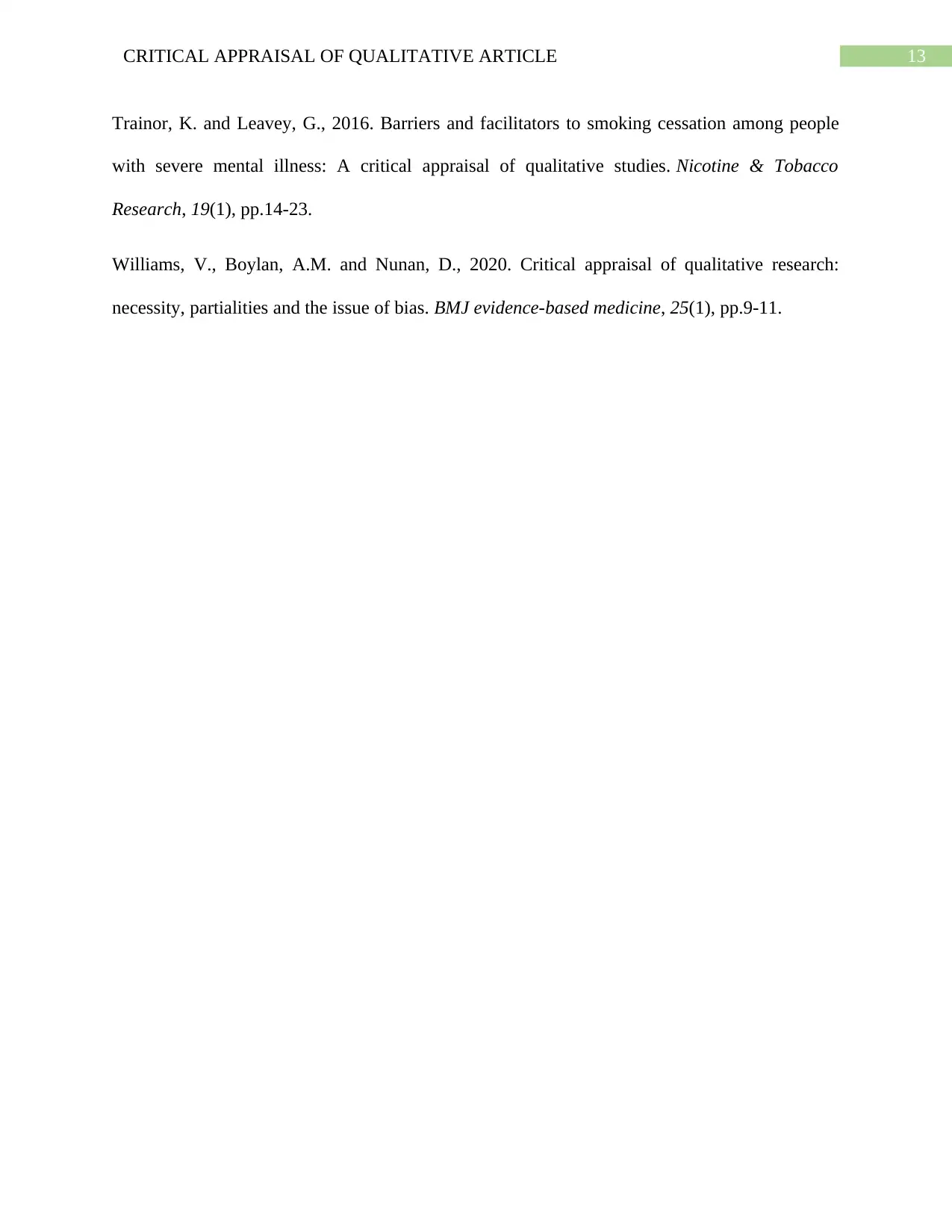
13CRITICAL APPRAISAL OF QUALITATIVE ARTICLE
Trainor, K. and Leavey, G., 2016. Barriers and facilitators to smoking cessation among people
with severe mental illness: A critical appraisal of qualitative studies. Nicotine & Tobacco
Research, 19(1), pp.14-23.
Williams, V., Boylan, A.M. and Nunan, D., 2020. Critical appraisal of qualitative research:
necessity, partialities and the issue of bias. BMJ evidence-based medicine, 25(1), pp.9-11.
Trainor, K. and Leavey, G., 2016. Barriers and facilitators to smoking cessation among people
with severe mental illness: A critical appraisal of qualitative studies. Nicotine & Tobacco
Research, 19(1), pp.14-23.
Williams, V., Boylan, A.M. and Nunan, D., 2020. Critical appraisal of qualitative research:
necessity, partialities and the issue of bias. BMJ evidence-based medicine, 25(1), pp.9-11.
1 out of 14
Related Documents
Your All-in-One AI-Powered Toolkit for Academic Success.
+13062052269
info@desklib.com
Available 24*7 on WhatsApp / Email
![[object Object]](/_next/static/media/star-bottom.7253800d.svg)
Unlock your academic potential
© 2024 | Zucol Services PVT LTD | All rights reserved.





